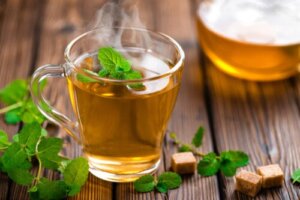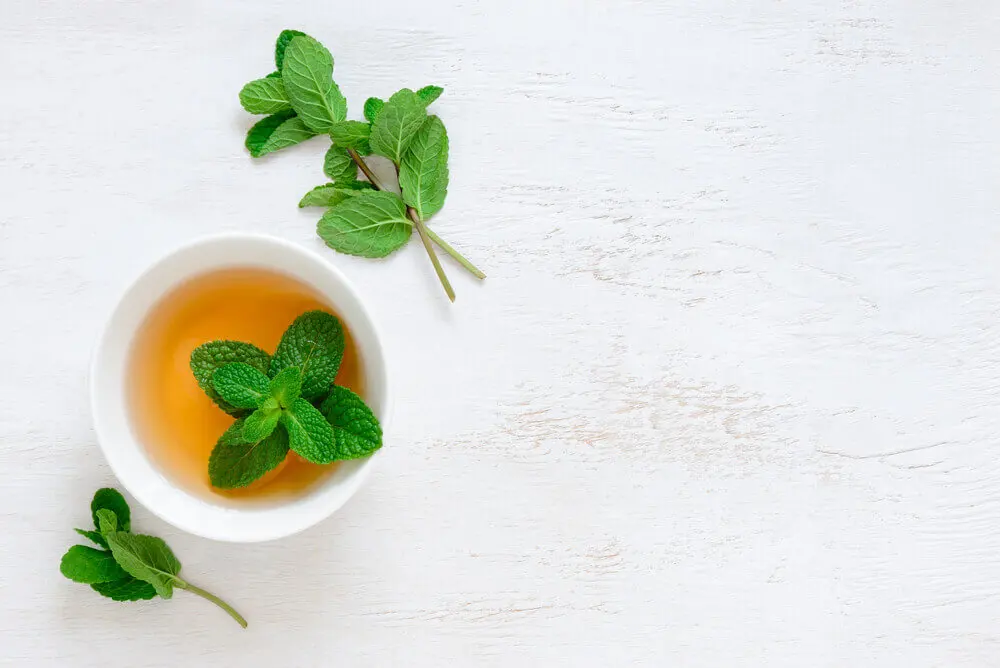Peppermint Tea: What It's Used For, Contraindications and Preparation


Reviewed and approved by the pharmacist Franciele Rohor de Souza
Peppermint tea is a drink made from the leaves of Mentha piperita, one of the different types of mint. In traditional medicine, it’s a well-known digestive remedy, as its intake is associated with the relief of nausea, indigestion, heartburn, and abdominal swelling. In addition to this, other interesting benefits are attributed to it.
As stated in a review shared in the Journal of Ethnopharmacology, the plant and its extracts have antimicrobial, hepatoprotective, antioxidant and anti-inflammatory potential. In particular, this is associated with its content of phenolic acids, flavonoids and lignans. Want to know more about it?
What is peppermint tea used for?
In traditional medicine, peppermint tea has been used since ancient times as a supplement to promote physical and mental well-being. And, even though it isn’t a first-choice treatment against diseases, its intake is useful when it comes to soothe some symptoms. Let’s have a look at its main uses in detail.
Digestive health
As we have mentioned, one of the main uses of peppermint tea has to do with digestive health. To be more precise, the drink helps to improve digestion and reduce symptoms such as nausea, vomiting and gas.
One of its main compounds, R(-)-carvone, has been linked to these effects. According to a study shared in Fitoterapia, this substance inhibits the muscular contractions of the digestive tract and, as a result, exerts an antispasmodic effect.
However, other research shows that the plant has antiparasitic, antimicrobial and anti-inflammatory qualities, which also contribute to the prevention of gastrointestinal disorders.

Another very useful article for you: Peppermint Oil Against Irritable Bowel Syndrome
Source of antioxidants
The consumption of antioxidants plays a relevant role in the prevention of cell damage caused by free radicals. In turn, this is related to the prevention of chronic diseases and premature aging. Did you know that peppermint tea is a source of antioxidants?
As detailed in an article in the journal Molecules, it contains rosmarinic acid, flavones, and flavanones (limonene and menthol). In fact, it’s an excellent source of vitamin C, as each 11-gram serving provides about 2% of the recommended daily intake of this nutrient.
Hormonal balance
While hormonal disorders should be addressed by a doctor or gynecologist, the consumption of peppermint tea can be a good complement. A study published in Phytotherapy Research associates the intake of this drink with anti-androgenic effects.
In addition, everything points to the fact that it stimulates the release of luteinizing hormones (LH), follicle-stimulating hormones (FSH), and estradiol, necessary for the ovulation process. Similar results were found in another piece of research, which associated the intake of this tea with benefits in patients with polycystic ovary syndrome (PCOS).
Memory
Substances contained in peppermint tea, such as carnosic acid or rosmarinic acid, are linked to beneficial effects on learning and memory. This is detailed in a study shared in Physiology & Behavior, which also found that these antioxidants protect the brain against oxidative stress.
Bacterial infections
It’s common to find oral care products containing peppermint. The reason? Not only does it freshen breath, but it has antibacterial properties that promote healthy teeth and gums. However, the tea is often used as a rinse to complement oral cleaning habits.
On the other hand, it’s used to disinfect food, as evidence indicates that it helps fight bacteria that cause food poisoning, such as E. coli and Listeria.
Controlling glucose levels
Peppermint tea is a drink that’s suitable for people with diabetes. Although more studies are needed on its properties, for now the evidence suggests that it helps control high blood sugar levels.
Stress relief
Drinking peppermint tea may induce relaxation during stressful times. In animal research, peppermint extracts exhibited positive effects in reducing anxiety and sleep problems.
Its menthol content is believed to interact with GABA receptors in the brain, reducing nervous activity.
Arthritis pain
The analgesic properties of peppermint tea are used as an adjuvant to reduce pain caused by arthritis. In this regard, a study published in the Journal of Medicinal Food reported that drinking peppermint twice a day reduced stiffness, physical disability, and pain in patients with knee arthritis.
Blood pressure
The (-)-carvone present in peppermint has been linked to lowering high blood pressure. It’s even said to have more ability to reduce blood vessel contractions than the drug verapamil. For now, more evidence is needed.
Contraindications and possible side effects of peppermint tea
Peppermint tea is generally well tolerated by most healthy adults. However, its consumption should be moderate and punctual.
However, there are some cases in which its intake is contraindicated:
- Pregnancy and lactation
- Renal diseases
- Hepatic pathologies
- Children under 5 years old
- Patients with a history of allergy to mint
- People undergoing treatment with liver medications or sedative drugs
Because peppermint can cause liver damage, it should be avoided if taking drug treatments that also have this damaging effect.
Likewise, it is not convenient to use this plant when taking sedative medications. The combination of both can facilitate the appearance of drowsiness and slow breathing.
Peppermint infusions are not indicated for children under 5 years of age and patients with a history of allergy to mint.

How to prepare peppermint tea?
The preparation of this tea is quite simple. It can be made with prepared bags, or with the loose leaves.
In general, it’s fine to consume 2 or 3 cups a day.
Ingredients
- 500 milliliters of water
- 30 grams (1.2 oz) of peppermint leaves
Instructions
- To begin, bring the water to a boil. Once it comes to a boil, remove from the heat and add the peppermint leaves.
- Cover the drink and let it steep for about 10 minutes.
- Then strain it through a strainer and consume it.
Discover more here: A Milk and Mint Remedy to Fight Intestinal Parasites
What should you remember about peppermint tea?
Tea prepared with peppermint leaves can be used to supplement food. It’s a low-calorie drink that promotes digestion and relief of certain ailments.
However, it shouldn’t be a first choice when treating illnesses. In case of any health problems, you should first consult with your doctor.
All cited sources were thoroughly reviewed by our team to ensure their quality, reliability, currency, and validity. The bibliography of this article was considered reliable and of academic or scientific accuracy.
- Akdoğan M, Tamer M. N, et al. (2007). Effect of spearmint (Mentha spicata Labiatae) teas on androgen levels in women with hirsutism. Phytotherapy Research. 21 (5): 444-7. https://pubmed.ncbi.nlm.nih.gov/17310494/
- Babaeian M, Naseri M. (2015). Herbal remedies for functional dyspepsia and tradicional iranian medicine. Iranian Red Crescent Medical Journal. 17 (11): e20741. https://www.ncbi.nlm.nih.gov/pmc/articles/PMC4698144/
- Bayani, M., Ahmadi-Hamedani, M., & Jebelli Javan, A. (2017). Study of Hypoglycemic, Hypocholesterolemic and Antioxidant Activities of Iranian Mentha Spicata Leaves Aqueous Extract in Diabetic Rats. Iranian journal of pharmaceutical research : IJPR, 16(Suppl), 75–82. https://www.ncbi.nlm.nih.gov/pmc/articles/PMC5963648/
- Caro D. C, Rivera D. E, et al. (2018). Pharmacological Evaluation of Mentha spicata L. and Plantago major L, Medicinal Plants Used to Treat Anxiety and Insomnia in Colombian Caribbean Coast. Evidence Based Complementary and Alternative Medicine. 7; 2018:5921514. https://pubmed.ncbi.nlm.nih.gov/30158996/
- Connelly A. E, Tucker A. J, et al. (2014). High-rosmarinic acid spearmint tea in the management of knee osteoarthritis symptoms. Journal of Medicinal Food. 17 (12): 1361-7. https://pubmed.ncbi.nlm.nih.gov/25058311/
- Farid O, El Haidani A, et al. (2018). Antidiabetic Effect of Spearmint in Streptozotocin-Induced Diabetic Rats. Endocrine Metabolic & Immune Disorder Drug Targets. 18 (6): 581-589. https://pubmed.ncbi.nlm.nih.gov/29769013/
- Farr S. A, Niehoff M. L, et al. (2016). Effect of botanical extracts containing carnosic acid or rosmarinic acid on learning and memory in SAMP8 mice. Physiological Behaviour. 165: 328-38. https://pubmed.ncbi.nlm.nih.gov/27527000/
- Hanafy, D. M., Burrows, G. E., Prenzler, P. D., & Hill, R. A. (2020). Potential Role of Phenolic Extracts of Mentha in Managing Oxidative Stress and Alzheimer’s Disease. Antioxidants (Basel, Switzerland), 9(7), 631. https://www.ncbi.nlm.nih.gov/pmc/articles/PMC7402171/
- Herrlinger, K. A., Nieman, K. M., Sanoshy, K. D., Fonseca, B. A., Lasrado, J. A., Schild, A. L., Maki, K. C., Wesnes, K. A., & Ceddia, M. A. (2018). Spearmint Extract Improves Working Memory in Men and Women with Age-Associated Memory Impairment. Journal of alternative and complementary medicine (New York, N.Y.), 24(1), 37–47. https://www.ncbi.nlm.nih.gov/pmc/articles/PMC5779242/
- Kennedy, D., Okello, E., Chazot, P., Howes, M. J., Ohiomokhare, S., Jackson, P., … & Wightman, E. (2018). Volatile terpenes and brain function: investigation of the cognitive and mood effects of Mentha× Piperita L. essential oil with in vitro properties relevant to central nervous system function. Nutrients, 10(8), 1029. https://www.mdpi.com/2072-6643/10/8/1029
- Mahboubi M. (2021). Mentha spicata L. essential oil, phytochemistry and its effectiveness in flatulence. Journal of Traditional and Complementary Medicine. 11 (2): 75-81. https://www.ncbi.nlm.nih.gov/pmc/articles/PMC7936090/
- Medline Plus. (2022). Spearmint. Biblioteca Nacional de Medicina de Estados Unidos. Consultado el 21 de febrero de 2023. https://medlineplus.gov/druginfo/natural/845.html#Safety
- Pytko-Polonczyk J, Stawarz-Janeczek M, et al. (2021). Antioxidant-rich natural raw materials in the prevention and treatment of selected oral cavity and periodontal diseases. Antioxidants. 10 (11): 1848. https://www.ncbi.nlm.nih.gov/pmc/articles/PMC8614929/
- Sadeghi Ataabadi, M., Alaee, S., Bagheri, M. J., & Bahmanpoor, S. (2017). Role of Essential Oil of Mentha Spicata (Spearmint) in Addressing Reverse Hormonal and Folliculogenesis Disturbances in a Polycystic Ovarian Syndrome in a Rat Model. Advanced pharmaceutical bulletin, 7(4), 651–654. https://www.ncbi.nlm.nih.gov/pmc/articles/PMC5788221/
- Shahbazi Y. (2015). Chemical Composition and In Vitro Antibacterial Activity of Mentha spicata essential oil against common food-borne pathogenic bacteria. Journal of Pathogens. 2015: 2015:916305. https://pubmed.ncbi.nlm.nih.gov/26351584/
- Souza F. V, da Rocha M. B, et al. (2013). (-)-Carvone: antispasmodic effect and mode of action. Fitoterapia. 85 : 20-4. https://pubmed.ncbi.nlm.nih.gov/23103297/
- Watt E. E, Betts B. A, et al. (2008). Menthol shares general anesthetic activity and sites of action on the GABA(A) receptor with the intravenous agent, propofol. European Journal of Pharmacology. 590 (1-3): 120-6. https://pubmed.ncbi.nlm.nih.gov/18593637/
- Wu Z, Tan B, et al. (2019). Chemical composition and antioxidant properties of essential oils from peppermint, native spearmint and scotch spearmint. Antioxidants. 24 (15): 2825. https://www.ncbi.nlm.nih.gov/pmc/articles/PMC6696458/
This text is provided for informational purposes only and does not replace consultation with a professional. If in doubt, consult your specialist.








